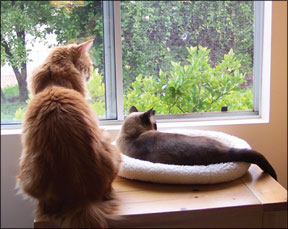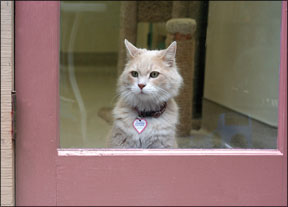It should come as no surprise that Mother Nature is on the verge of taking a permanent sick day. After all, harmful climate changes due to greenhouse gases, air and water pollution, and the destruction of natural habitats are putting our planet and its inhabitants – both two- and four-legged – in peril.
Hopefully, many of us have begun to make some changes in our daily lives to help reverse the damage done to, well, everything.

Bev Caldwell
288
But what role can our cats play in being good stewards of our beleaguered planet? There are many practical ways to reduce your felines carbon pawprint, which include switching to a corn or wheat-based cat litter and recycling cat food containers instead of throwing them in the trash.
Get a jump start on Earth Day (April 22) by incorporating the following tips into your daily routine. Start out slowly if you wish by trying one or two new tips each week. Encourage your friends, family members and co-workers to join in your quest for a sustainable future. Youll find that its not only fun and easy to “go green,” but youll see that you can make a positive and lasting impact on our world, which will please Mother Nature.
(1) Use eco-friendly cat litter. The problem with most clay-based cat litter is that the clay must by “strip mined” from the ground, which wreaks havoc on the environment. The U.S. Bureau of Mines estimates that in 1994 alone, approximately 1.5 million metric tons of clay was mined to make clay cat litter. Today, consumers have many more choices when it comes to cat litter: Natural products made from corn, wood pulp and pine are increasingly available from leading pet retailers. Keep in mind that, given the choice, most cats prefer an unscented litter with small granules (sandy) for easy digging.
If you choose to continue using clay cat litter, you can still help the environment. Wrap the waste in a sheet of newspaper or throw it in the trash loose, rather than sealed in a plastic bag. Plastic doesnt break down, essentially trapping anything inside the bag so it cant decompose.
(2) Feed your cat organic pet food. If you want to feed your cat a wholesome diet – one that is free of animal by-products, pesticides, hormones, antibiotics, or artificial preservatives and ingredients – consider an organic pet food, which is made with your pets health and the health of the environment in mind.
“Organic refers to the process rather than the product,” says Edward Moser, MS, VMD, board-certified veterinary nutritionist and adjunct assistant professor of nutrition at the University of Pennsylvania School of Veterinary Medicine, and a member of the USDAs National Organic Programs Pet Food Task Force. “In other words, organic looks at the whole process, from where the feeds are grown to how the animals are fed. A cow or chicken must not only be raised in a pasture that doesnt use chemicals, hormones or pesticides, but they must be fed foods that are grown organically,” Dr. Moser says.
(3) Give your cat all natural toys. Theres nothing quite as much fun as watching your cat streak across the living room floor in pursuit of a favorite toy. After all, a stuffed mouse or feather toy provides your cat (and you!) with hours of exercise and entertainment. Many cat toys on the market are made with organic and recycled materials. For instance, your earth-conscious cat will likely pounce on a hemp-filled mouse or organic catnip toy and will enjoy scratching her nails on an all-natural, corrugated cardboard scratcher.
If youre pinching pennies, you can make your own cat toys out of

Bev Caldwell
288
old socks, cardboard boxes or even crumbled pieces of newspaper. Avoid using yarn, ribbon, rubber bands, paper clips, plastic milk jug rings or anything else that can be swallowed. All of these items are dangerous to cats and can cause serious injury.
(4) Provide your cat with eco-friendly bedding. Its a fact that most cats snooze up to 20 hours a day, so why not provide them with environmentally-friendly pet beds that are stylish, functional and, best of all, comfy for those long catnaps? Many beds are made from durable fleece, organic cotton and other natural materials. Visit your local pet store or do a search online for “organic pet beds.”
(5) Adopt a cat from an animal shelter or rescue group. Stephen Zawistowski, PhD, Executive Vice President for the ASPCA in New York City estimates that four to six million cats and dogs enter animal shelters each year and approximately two to three million of those animals are euthanized because not enough homes are available. “Its really great to adopt a cat because it fits into the whole “green” concept of shopping local,” says Dr. Zawistowski. “This isnt a cat from a mass breeding facility that is going to be shipped across country. Its a cat thats been living in a community and will be staying within that community.” By adopting a “recycled” cat, you are not only helping your community, but youre saving a life as well.
(6) Spay or neuter your pet. Once youve adopted that new cat or kitten, be sure to have them spayed (females) or neutered (males). [Note: most animal shelters ensure that all pets are altered before you adopt them. Others may offer a spay/neuter voucher, which you can redeem at a local animal clinic.] Spaying or neutering helps reduce the pet overpopulation problem and wards off many devastating diseases seen in “intact” animals. Your cat will be healthier and, as a side benefit, you may not make as many trips to the veterinary office with a sick cat, so your automobile isnt adding greenhouse gases to the environment.
(7) Use natural grooming products and pest repellents. Watch out for shampoos and grooming products that contain petrochemicals like propylene glycol, a strong skin irritant. Your cat will lick her fur and ingest the toxic chemicals, which may cause her to become ill. Instead, look for herbal pet grooming products derived from plant-based and other natural sources. After bathing your cat with a chemical-free shampoo, use a prescription flea and tick product, which is much safer and more effective than many over-the-counter store brands. Be sure to consult your veterinarian before using any prescription flea and tick control products.
(8) Use natural home and garden products. Many commercial home and garden products contain chemicals that are toxic to pets (and people) if ingested. In addition, many human medications such as aspirin, acetaminophen and ibuprofen can be fatal to cats. Keep all cleaning products and medications in tightly sealed containers and out of reach of your pets.
Better yet, go natural! Your local health food store has many kinds of eco-friendly, biodegradable household cleaners and other safe and effective products for home use. These products are safe for both pets and people and are not tested on laboratory animals. You can also find many non-toxic cleaning products that are sitting in your pantry right now, from lemons to vinegar and baking soda.
(9) Recycle. Every year, billions of tons of garbage end up in landfills and its not going anywhere soon. Non-biodegradable plastic bags, for instance, take up to 1,000 years to degrade. And they dont just sit there: As the bags break down, they spew out toxic chemicals, which contaminate our soil and water. Pet food cans, on the other hand, are made from aluminum and, when recycled, are reprocessed into new aluminum cans. Instead of discarding used pet food cans in the trash – where they will end up clogging a landfill – salvage the cans by taking them to your local recycling center. Be sure to rinse the cans with a little water before recycling them to discourage pests.
(10) Keep your cats indoors. Cats that are allowed outdoors can have a negative effect on the eco-system; they stalk songbirds and compete with local wildlife that prey on birds and small mammals. In addition, outdoor cats are at risk of being injured or killed by cars, other animals or disease. “If you are leaning to green, one of the things you can do is to keep your cats indoors so they dont have that kind of impact on the environment,” says Dr. Zawistowski. “From a green standpoint, keeping your cats indoors is good for your cats and good for the planet.”



